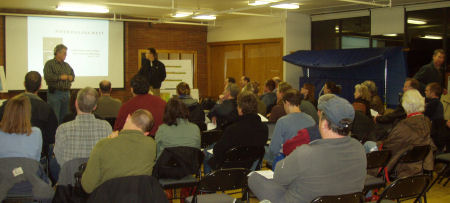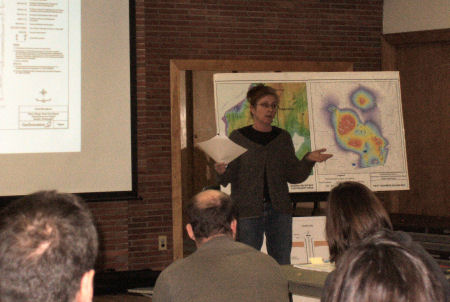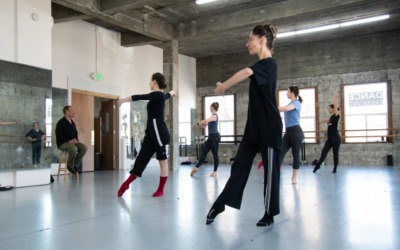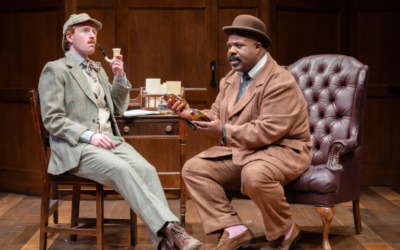More than 50 residents of Greenwood and Phinney Ridge packed a meeting room at Loyal Heights Community Center Thursday night for an environmental review of the proposed Fred Meyer project on 85th Street.
This meeting focused on soil and groundwater issues only, not design. (The city’s Design Review Board approved the project’s preliminary designs in September.) The project includes not only a Fred Meyer store but up to 250 residential units and about 20,000 square feet of other retail, and will be called Pipers Village West.
The meeting began at 7 p.m. and was scheduled to end at 8:30 p.m., but lasted until after 9:30 p.m. The first 45 minutes was given to the project team to explain their hydrology studies of the site. The remaining time was given to neighbors to voice their concerns, which many did – vigorously.
The main issue revolves around the fact that approximately half of the project will be built on the Greenwood Bog. The peat bog covers a large area of downtown Greenwood. Issues arise when water is removed from the bog – called “dewatering” – causing houses and streets to sink.
GGLO Architect Ted Panton started off by explaining the concept of “infiltration” – which is when water moves from the surface into the ground in a variety of ways, whether through pervious paving or gutters or landscaping. Moving the water back into the bog is a good thing, because you want to keep it hydrated. It’s when you remove water from that compressible soil that it causes sinking.

City Planner Scott Kemp, in the background on the left, and GGLO Architect Ted Panton, in the background on the right, go over hydrology issues.
“This is one of the largest peat bog occurrences in the Seattle area, and that is really the critical issue for this project,” said Michael A.P. Kenrick, a hydro-geologist with GeoEngineers Inc., who was hired by Fred Meyer. “We want to try and preserve the existing nature of the peat. Everybody recognizes the significance of that soil. It’s very compressible. The whole emphasis here is to protect the peat and keep it from losing moisture.”
Kenrick said they have drilled 30 “bore holes” in various sites around the project and installed monitoring wells to get soil samples. He said that was a very high number of bore holes for a project such as this. They look at whether the soil is silt, sand, clay or peat, and how wet it is. The project needs to stay well above the water table, which is the area of saturation.
The bog area contains three different layers of soil. The top thin layer is peat. In some areas the peat is about three-and-a-half to four feet; the thickest location is about eight-and-a-half feet. The middle layer is silt. The bottom layer is glacial till, also called hard pan. The Peat Settlement Prone Areas Ordinance prevents them from constructing anything below ground water elevation.
Hal P. Grubb, director of engineering services for Barghausen Consulting Engineers Inc., hired by Fred Meyer, said the existing Fred Meyer site is almost entirely covered with impervious surface. Storm water is now collected in downspouts and catch basins in the parking lot, and routed straight into the city storm drain system on 87th Street and 1st Avenue. Then it travels to the north and out to Puget Sound, with no control or treatment measures, which is common for older projects.
However, the new project would collect it and meter it out either into the ground or into the city storm water system. The idea is to put as much of the collected water into the peat as the peat will accept – thereby keeping it hydrated – and put any overflow into an underground retention vault. Water in the vault would be metered out into the city system. The vault would be large enough to handle so-called “100-year event” flooding before it overflowed.
Many neighbors brought up sinking issues they believe were caused when the Safeway was built on 87th and Greenwood a few years ago. Some neighbors said they had to pay to jack up part of their houses and that their basements routinely flood.
Kate Martin, a long-time vocal critic to the project, has long complained that putting most of the proposed one-story Fred Meyer underground would cause irreparable harm to the bog and surrounding areas. She called it a “submarine superstore.”

Kate Martin argues that the project will harm surrounding properties.
“We knew that dewatering in and around this area damages public infrastructure and private property, because when peat is robbed of its water source because of dewatering, peat dries, compresses and sinks and anything resting on it goes down with it when it sinks,” Martin said. “Greenwood has been sinking and continues to sink.”
She said there has been a lack of data and science surrounding the project, and that too many assumptions are made. She – and many others in the audience – wondered why the city had not yet ordered an Environmental Impact Statement. Currently, the project only needs a Determination of Non-Significance (DNS).
City Planner Scott Kemp said the city had not yet made the decision on whether an EIS is needed, and that the first step is to approve or deny the DNS. One woman in the audience asked for a show of hands as to who wanted to see an EIS. Nearly every hand went up.
“It’s a very fragile site,” the woman said. “There are impacts, impacts and impacts. I know you can look at all the numbers in lots of different ways. So who’s going to be helping me when I have to move out of the city when my house sinks and I can’t afford to lift it up? It’s a serious possibility for some of us.”
Many others in the audience wanted to know how they could get relief if their houses do sink during or after construction of the project.
“My house is already sinking. I’ve been there five years and I’ve had to raise my house an inch and a half on one corner,” one man said. “What are the assurances that homeowners around the area won’t be affected?”
“If you do the things right on the project itself, there shouldn’t be any impacts on surrounding sites,” Kenrick answered.
A woman who lives directly across the street from the site on 87th Street said the city pipes in the street in front of her house have burst four times in the last few years. Kemp seemed surprised by that. “As you’re building, are our water pipes going to burst again?” she asked.
Matt Heilgeist, who lives across from the project, says he assumes there will be some movement of his home during the project. He asked if the city could establish baselines and elevations for neighboring houses before the project starts, then compare them afterwards. Kemp said the city could look into that.
“My approach is to be as careful as we can. We really don’t feel like we have experts who are trying to fool us,” Kemp said of Fred Meyer’s development team. “They are spending millions and millions of dollars…and do seem to want to do what’s right.”
Note: The meeting was long and many, many people spoke passionately, and there’s no way I can cover everything that was said. So if you think I’ve missed anything important, please put your two cents’ worth in below in comments.
One more thing: If you received a notice in the mail about the meeting from the Department of Planning & Development, then you’re already on the official mailing list for this project. If you didn’t and you want to be on the list, email Scott Kemp with your snail mail address.
Neighbors grill Fred Meyer, city over environmental concerns





